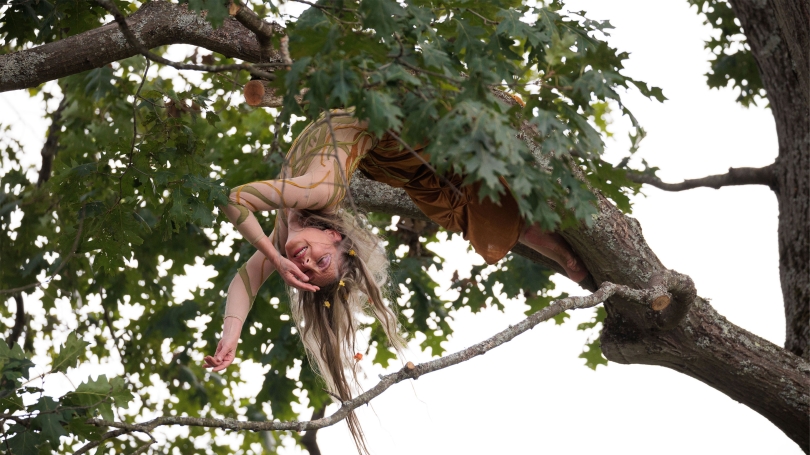Dancing with the Elements
Albert Einstein believed that all religions, arts and sciences are branches of the same tree, directed toward ennobling man's life. Likewise, Herstory of the Universe@Dartmouth brings together science and the arts to help us deepen our connection with the world around us. Hop Curator of Academic Programming Samantha Lazar talks to choreographer Richard Move and Dartmouth postdoctoral researcher Jessica Trout-Haney about the inspiration behind the work, the former golf course's ecosystem and the intersection of science and the arts.
Samantha Lazar: Richard, I'd love to start by asking, where did the idea for Herstory of the Universe come from?
Richard Move: There are different inspirations. I've always been drawn to immersive, site-specific, site-responsive work. And I feel that it is an opportunity as well for me and our cast and team and audiences to really stop and contemplate these amazing aspects of nature that surround us and that we might be taking for granted. For example, we might walk by these different sites on the golf course and think they are beautiful, but not necessarily pay close attention to them and to their importance in the ecosystem and to the amazing complexity these spots bring into the natural environment that surrounds us.
Samantha Lazar: One of the sites featured in Herstory is Occom Pond. Jess, you are an aquatic ecologist. Can you tell us what's so cool or unique about Occom Pond?
Jessica Trout-Haney: Occom Pond represents a freshwater resource, and freshwater bodies are extremely important, especially now as we increasingly recognize how scarce a resource they've become. It houses a lot of important organisms, and it has a long history as well. As an aquatic ecologist, I study cyanobacteria. One of the first things you notice in the summer is how green the pond is, and that green is actually conglomerations, or groups of cyanobacteria that work together and photosynthesize. These live very happily in Occom Pond. But they also create potential problems that balancing out the aquatic ecosystem can help to mediate.
Samantha Lazar: Tell us about the research process for Herstory. What are some of the scientific tidbits that emerged through your conversations with our faculty that you found inspirational, or that made their way into Herstory.
Richard Move: It's been wonderful to connect with different people to reveal the complexities and some details about each of the sites. For example, the dance that takes place at Occom Pond very much grew out of these different meetings with faculty. It was inspired by the return of the osprey population to the region. They had been disappearing due to the use of specific pesticides, which have thankfully been outlawed. And so now we have a return of this bird population to the region.
Another idea that emerged in various conversations was the complexity, intricacy and nuance of all the different food chains in these different kinds of subsets of ecosystems. For instance, the third piece is a trio I call Trophic Cascade, which is a reference to an ecological term for interactions that occur that alter the food chain, and how everything is so interconnected. One kind of little disruption might affect every part of the food chain on the site.
Samantha Lazar: Lastly, I'd love for you to tease out a little bit the intersections between science and art for you. Jess, you're a dancer as well as a scientist. How do both disciplines cross in your work and in how you see the world?
Jessica Trout-Haney: They don't occupy very different spaces in my mind. I like science because I'm very inspired by nature, and it makes me curious, and it makes me want to learn more. That feeling of inspiration directly feeds into my movement and dance. When I choreograph, they are tightly connected. Having curiosity is helpful both in art and in science, and the two can really feed each other. I've found that exploring movement with my body helps me to explore movement in space and in science as well.
Samantha Lazar: Richard, would you add anything to those intersections between art and science and dance?
Richard Move: I think one of my big inspirations is this notion of how we experience the climate and our natural surroundings. We experience them through the body, and I like to think that our project, Herstory, amplifies that.
Herstory of the Universe@Dartmouth is showing Sep 15 -17 at the Dartmouth Outing Club House. Learn more about Richard Move's residency with the Hop and their discussions with Dartmouth faculty here.





